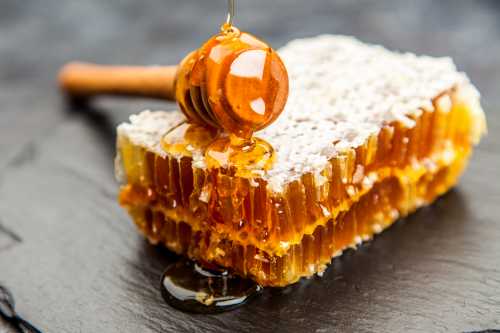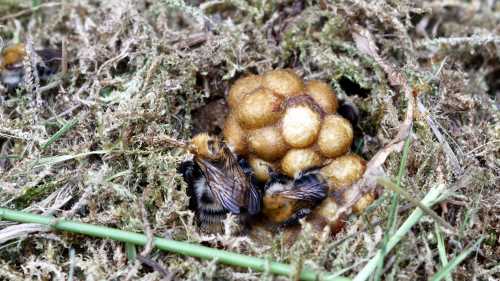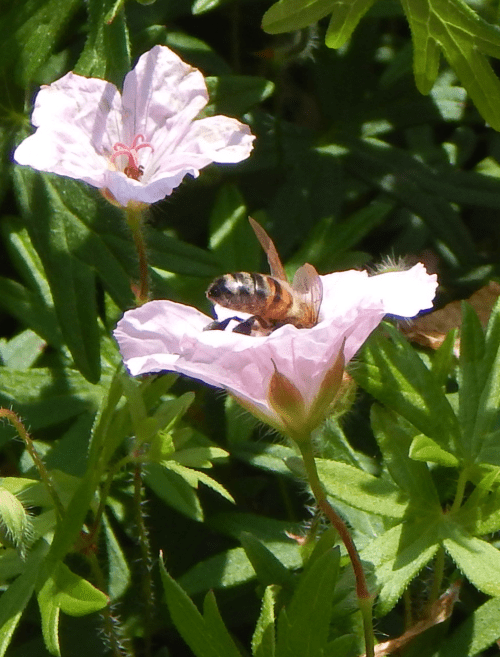Do Bumble Bees Make Honey?
Updated: November 2023
Everyone knows honey bees make honey. But what about bumble bees?
Question:
Do bumble bees make honey?
The short answer is:
No, at least, not in the way we think of honey.
The honey we purchase in jars, is the harvested winter food store of the honey bee, which is made from nectar gathered by honey bees and with an enzyme added.
Inside the wax honeycomb, the collected nectar goes through a transformation process to create honey, which is stored for winter to feed the colony.
Bumble bees do not create winter food stores, and so the nectar they gather does not undergo a transformation period to create the honey we are familiar with. However, bumble bees have their own 'version' of nectar stores, and sometimes, the nectar pots are referred to as 'honey pots'.
What honey is, and why it's only made by honey bees
 Honeycomb made by honey bees.
Honeycomb made by honey bees.Here is a definition of honey as stipulated in Codex Alimentarius produced by the Food and Agriculture Organisation of the United Nations1:
"Honey is defined as 'the natural sweet substance produced by honey bees from nectar of blossoms or from secretions of living parts of plants or excretions of plant sucking insects on the living parts of plants, which honey bees collect, transform and combine with specific substances of their own, store and leave in the honeycomb to ripen and mature".
I have added the bold emphasis to stress the importance of the honey bee's own added ingredient that is key to the creation of honey: the honey bee enzyme, invertase.
Invertase is secreted from the salivary and hypopharyngeal of bees, and varies in amount depending on the developmental stage of the workers2.
Invertase is an important honey enzyme, since (among other things) it converts nectar and honeydew into honey, hydrolyzing sucrose into fructose and glucose3.
There are additional processes involved in the transformation of nectar into the sweet, high-sugar, viscous honey found in honeycombs (it should be remembered that untransformed nectar has high water content, and is not as sweet as honey) .
After the bees have deposited the nectar into the wax, hexagonal cells, it is fanned by bees until it becomes thicker and more concentrated. Once the nectar has turned into honey, it is ‘capped’ (which means the bees add a layer of wax), and will be accessed by the colony again to supply their food needs over the winter months.
You can read more detail on my page what is honey?
Do bumble bees make honey? Not really. Bumble bees store nectar in pots - but only for a while
Bumble bees do not store food for long periods in the same way as honey bees, although they do have temporary nectar stores.
Once a newly emerged bumble bee queen has found a suitable nest site, she provisions it with a ball of pollen mixed with nectar and builds a single nectar pot composed of wax. Close to the nectar pot, the queen will lay her first clutch of eggs, in the ball of pollen and incubate them4.
Whilst incubating the eggs, the queen is able to sustain herself (and later, other workers) by feeding from the pot of nectar, which is sometimes (perhaps a little misleadingly) referred to as a 'honey pot'.
What bumble bees have then, is short-term nectar stores for food, and in comparison with honey bees, bumble bees store only a tiny amount for a short period of time. There is no extended transformation period, and the nectar is gathered and stored in the wax pots in much smaller quantities.
Of course, humans do not harvest bumble bee nectar stores for human consumption (at least, not in the West) – although there are indeed animals that will happily eat the contents of a bumble bee nest, complete with nectar stores and larvae.

Why Don’t Bumble Bees Make Honey In The Same Way As Honey Bees?
This is because bumble bees have a much shorter life cycle than honey bees, and therefore, they do not need to store food over the winter period.
At the end of the season, only the new queens will survive and hibernate through the winter, whilst the rest of the colony (the older queen, workers and males) will not.
This means there is no need for bumble bees to store food to feed the colony during winter months.
Read about the bumble bee life cycle.
 Bumble bees foraging on Helianthus flower.
Bumble bees foraging on Helianthus flower.Healthy honey bee colonies should thrive through the winter, and because of this, they need winter stores: honey.
 Honey bees gather nectar from flowers to turn into honey.
Honey bees gather nectar from flowers to turn into honey.References
1. CODEX ALIMENTARIUS, INTERNATIONAL FOOD STANDARDS, Food And Agriculture Organization Of The United Nations: STANDARD FOR HONEY CXS 12-19811.
2. Livia Persano Oddo, Maria Gioia Piazza, Patrizio Pulcini. Invertase activity in honey1. Apidologie, Springer Verlag, 1999, 30 (1), pp.57-65. ffhal-00891566f.
3. Adriane Alexandre Machado De-Melo, Ligia Bicudo de Almeida-Muradian ,María Teresa Sancho & Ana Pascual-Maté (2017): Composition and properties of Apis mellifera honey: A review, Journal of Apicultural Research, DOI: 10.1080/00218839.2017.1338444.
4. Belsky JE, Camp AA, Lehmann DM. The Importance of Males to Bumble Bee (Bombus Species) Nest Development and Colony Viability. Insects. 2020;11(8):506. Published 2020 Aug 5. doi:10.3390/insects11080506.




